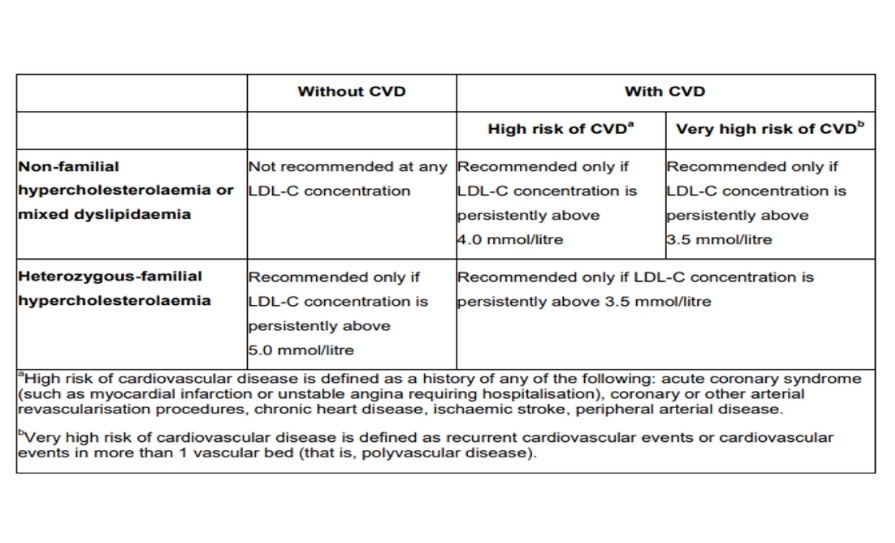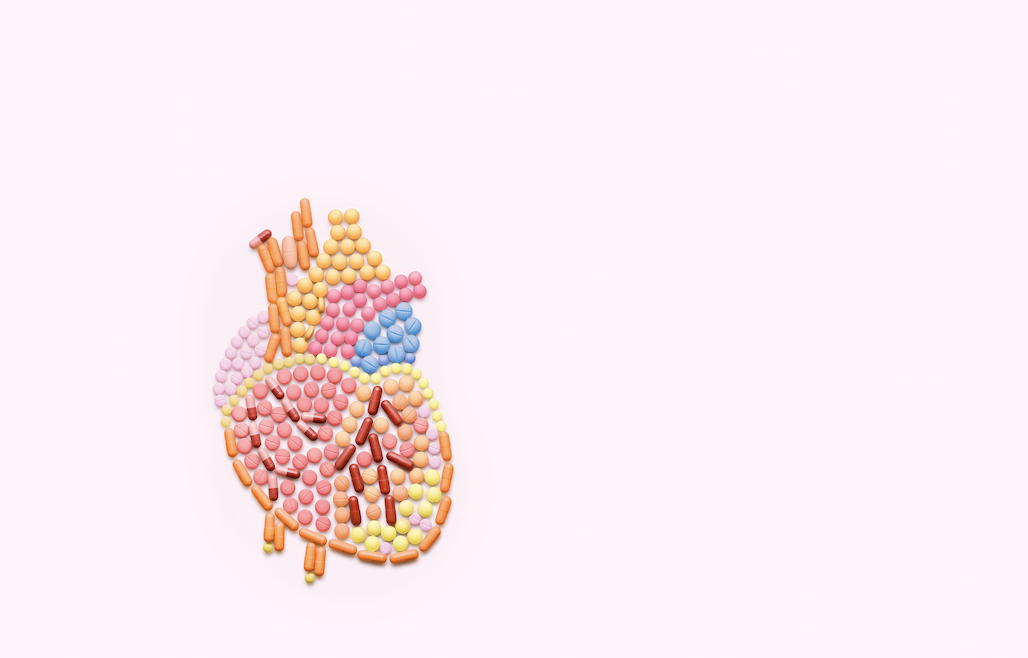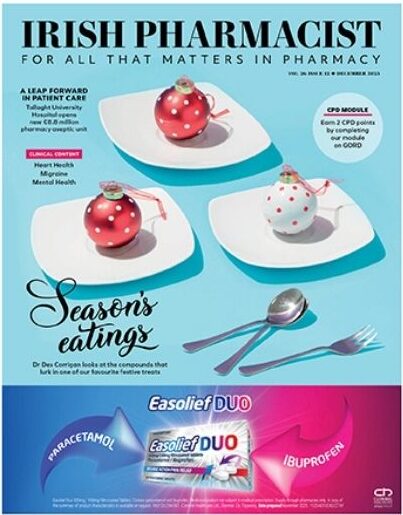Eamonn Brady MPSI looks at the role of cholesterol in the body and how it can be managed to prevent a number of serious conditions
Cholesterol is a lipid (fat). It is manufactured by the liver from the fatty foods that we eat, and plays a vital part in allowing the body to function normally. Cholesterol is present in the membrane (outer layer) of every cell in the body. It insulates nerve fibres and is an essential building block for hormones, such as the sex hormones, and the hormones of the adrenal cortex. It also enables the body to produce bile salts.
Cholesterol is carried in the blood by molecules called lipoproteins. There are several different lipoproteins, but the three main types are:
- Low density lipoprotein (LDL). This is often known as ‘bad cholesterol’ and is thought to promote arterial disease. It carries cholesterol from the liver to the cells and can cause a harmful build-up if there is too much for the cells to use. Normally, the blood contains about 70 per cent of LDL but the level will vary from person-to-person. The recommended LDL level is below 3.37mmol/l.
- High density lipoprotein (HDL). This is often referred to as ‘good cholesterol’, and is thought to prevent arterial disease. It takes cholesterol away from the cells and back to the liver, where it is either broken down or is passed from the body as a waste product. Recommended HDL range is 1.45-4mmol/l.
- Triglycerides are another type of fatty substance present in the blood. They are found in dairy products, meat, and cooking oils. Triglycerides are also produced by the liver. Those who are overweight, have a diet that is high in fatty or sugary foods, or drink a large amount of alcohol, have an increased risk of having a high triglyceride level. Recommended triglyceride level is below 1.71mmol/L.
The amount of cholesterol present in the blood can range from 3.6-7.8mmol/l. A level above 6mmol/l is considered high, and a risk factor for arterial disease. A total cholesterol level of below 5.2mmol/l is recommended to prevent heart disease.
Evidence strongly indicates that high cholesterol levels can cause narrowing of the arteries (atherosclerosis), heart attacks, and strokes. The risk of coronary heart disease also rises as blood cholesterol levels increase. If other risk factors, such as high blood pressure and smoking, are present, the risk increases even more.
High cholesterol is not a disease in itself, but it is linked to serious conditions, such as cardiovascular illness, angina, stroke, and mini-stroke
Symptoms
High cholesterol is not a disease in itself, but it is linked to serious conditions, such as cardiovascular conditions, angina, stroke, and mini-stroke, known as transient ischaemic attack (TIA). A high level of cholesterol in the blood, together with a high level of triglycerides, can increase the risk of developing coronary heart disease.
Coronary heart disease is caused by a narrowing of the arteries that supply the heart with blood. This narrowing of the arteries is called atherosclerosis. Fatty deposits, such as cholesterol, cellular waste products, calcium, and other substances build up in the inner lining of an artery. This build-up, known as plaque, usually affects small and medium-sized arteries. The flow of blood through the arteries is restricted as the inside diameter is reduced. Blood clots, which often happen in the coronary arteries during a heart attack, are more likely to develop when arterial walls are roughened by the build-up of fatty deposits.
A high cholesterol level may only be revealed with symptoms of atherosclerosis. These can include:
- Angina: Caused by narrowed coronary arteries in the heart.
- Leg pain on exercising: Due to nar- rowing of the arteries that supply the lower limbs.
fBlood clots and ruptured blood vessels: Can result in a stroke or mini stroke/TIA. - Ruptured plaques: Can lead to a blood clot forming in one of the arteries delivering blood to the heart (coronary thrombosis), and may lead to heart failure if a significant amount of heart muscle is damaged.
- Thick yellow patches (xanthomas): Seen around the eyes or elsewhere on the skin. These are cholesterol deposits and can often be observed in people with inherited or familial cholesterol (where close family members have a history of high cholesterol).
Causes
A number of different factors can con- tribute to high blood cholesterol:
1. Lifestyle risk factors
There are a number of preventable lifestyle-related risk factors that can increase the risk of developing high blood cholesterol.
They include:
Unhealthy diet: Some foods contain cholesterol – known as dietary cholesterol – for example, liver, kidneys, and eggs. However, dietary cholesterol has little effect on blood cholesterol. More important is the amount of saturated fat in the diet. Foods that are high in sat- urated fat include red meat, meat pies, sausages, hard cheese, butter and lard, pastry, cakes, biscuits, and cream, such as soured cream and crème fraiche. fLack of exercise or physical activity: Can increase level of bad cholesterol (LDL) and decrease level of good cholesterol (HDL).
Obesity: Being overweight means an increased risk of high LDL and a de- creased level of HDL, increasing overall blood cholesterol level.
Smoking.
Drinking excessive amounts of alcohol: The recommended amount is three-to-four units a day for men, and two-to-three units a day for women.
2. Treatable risk factors
- Hypertension.
- Diabetes.
- A high triglyceride blood level.
- Medical conditions: Kidney and liver diseases, and an under-active thyroid gland.
3. Fixed risk factors
- A family history of heart disease or stroke: A person is more likely to have high cholesterol if a close male relative (father or brother) aged under 55, or a female relative (mother or sister) aged under 65, has been affected by coronary heart disease or stroke.
- A family history of cholesterol-related conditions: For example, if a close relative, such as a parent, brother, or sis- ter has familial hypercholesterolaemia, or combined hyperlipidaemia.
- Being male: Men are more at risk of having high blood cholesterol than women.
- Age: The older we get, the greater the likelihood of developing atherosclerosis.
- Early menopause in women.
- Ethnic group: People who are of Indian, Pakistani, Bangladeshi, or Sri Lankan descent have an increased risk of high blood cholesterol.
If a patient has a fixed risk factor (or several fixed risk factors), it is even more important to take steps to address any lifestyle or treatable risk factors.
Reduction in death rate from CHD in Ireland over the last 35 years
According to research published in the Journal of Epidemiology and Community
Health in 2006, changes in three classic cardiovascular risk factors (smoking, cholesterol, and blood pressure) contributed to a 61.9 per cent decrease of total coronary heart disease (CHD) mortality in Ireland between 1985 and 2000. This was consistent with studies in other developed countries.
In Ireland in 2000, heart disease was the leading cause of death, being responsible for 41 per cent of all deaths. In 2020, Central Statistics Office (CSO) figures show that diseases of the circu- latory system (which includes CHD) were responsible for 26.3 per cent of all deaths.
Smoking reduction, better diagnosis of cholesterol and hypertension, and better and earlier treatment interventions are all important factors contributing to this drop in deaths from heart disease. The better availability and affordability of statins in controlling cholesterol is also seen as a major factor that has reduced deaths from CHD.
Diagnosis
To measure cholesterol, a simple blood test is often carried out. Before the test is done, it is best not to eat for 12 hours (usually including the night-time when asleep). This ensures that all food is completely digested and will not affect the outcome of the test. A GP, practice nurse, or pharmacist can carry out the blood test. They will take a sample by either using a needle and a syringe or by pricking a finger.
The blood sample that is taken will be used to determine the amount of LDL (bad cholesterol), HDL (good cholesterol), and triglycerides in blood. Blood cholesterol is measured in units called millimoles per litre of blood (mmol/l). It is recommended a total blood cholesterol level of less than 5mmol/l, and an LDL cholesterol level of under 3mmol/l.
Anyone can have their blood choles- terol level tested, but it is particularly important to have it checked if you:
- Are aged over 40.
- Have a family history of cardiovascular disease: For example, if your father or brother developed heart disease, or had a heart attack, or a stroke before the age of 55, or if your mother or sister had these conditions before the age of 65.
- Have a close family member has a cholesterol-related condition: Examples include familial hypercholesterolaemia or combined hyperlipidaemia.
- Are overweight or obese.
- Have high blood pressure (hypertension).
- Have a medical condition: Examples include a kidney condition, an under-active thyroid gland, or acute inflammation of the pancreas (acute pancreatitis). This is because these conditions can cause an increased level of cholesterol.
In assessing risk of cardiovascular dis- ease, heart attack, or stroke, cholesterol ratio should not be taken on its own. Lifestyle factors should also be taken into consideration. For example:
- Smoking.
- Diet.
- BMI (body mass index or weight in relation to height).
- Treatable risk factors, such as high blood pressure and diabetes.
- Fixed risk factors, such as age, sex, and ethnicity.
Complications of high cholesterol
High cholesterol levels can be made worse by other medical conditions such as an under-active thyroid gland, an overactive pituitary gland, liver disease, or kidney failure.
Some people have inherited disorders, such as familial hypercholesterolaemia, or combined hyperlipidaemia, that prevent fats from being used properly and eliminated from the body. This allows the level of cholesterol to build up in the blood.
The major complications of raised blood cholesterol are heart attacks, strokes, and arterial disease. The risks of all of these are increased if the patient is/has:
- Overweight.
- A smoker.
- High blood pressure.
- A strong family history of these conditions.
- Diabetic.
Prevention
Patients can prevent high blood cholesterol by eating a healthy, balanced diet that is low in saturated fat. Including a small amount of unsaturated fats in the diet is a healthy choice, as this type of fat can actually reduce cholesterol levels. Current thinking is that the traditional Mediterranean diet, with its emphasis on raw olive oil in many foods, and low animal-fat content, is effective in ensuring cardiovascular health.
Foods high in unsaturated fats include:
- Oily fish.
- Avocados.
- Nuts and seeds.
- Sunflower, rapeseed, and olive oil.
- Vegetable oils.
Treatment
When diagnosed with high cholesterol, the first method of treatment will usually involve making dietary changes (adopt- ing a low-fat diet), and ensuring plenty of regular exercise. After a few months, if the cholesterol level has not dropped, the advice may be to take cholester- ol-lowering medication.
Diet
It is important to ensure a healthy diet by changing to one that is low in saturated fats which can reduce the level of LDL or bad cholesterol. If the person is in a high-risk category of getting cardiovascular disease, altering his or her diet will not lower risk sufficiently. A healthy diet includes foods from all different food groups including carbohydrates (cereals, wholegrain bread, potato, rice, and pasta), proteins (for example, from lean meat, such as chicken, and oily fish, like mackerel or sardines), and fats (varieties that are unsaturated, such as low-fat, mono- or poly-unsaturated spreads, and vegetable or sunflower oil). At least five portions of a variety of different fruit and vegetables should be eaten daily.
Cholesterol-lowering medication
There are several different types of cholesterol-lowering medication which work in different ways. Commonly prescribed medication includes:
- Statins (HMG-CoA reductase inhib- itors), such as simvastatin and atorvastatin, work by blocking the enzyme (chemical) in the liver that is needed to make cholesterol. Statins are used to reduce cholesterol to less than 4mmol/l and LDL cholesterol to less than 2mmol/l. They are, therefore, useful in preventing and treating atherosclerosis which can cause chest pain, heart attacks, and strokes. Statins sometimes have mild side-effects which can include constipation, diarrhoea, headaches, and abdominal pain.
- Aspirin may be recommended, depending on age and several other factors. A low daily dose of aspirin can prevent blood clots from forming. (Children under 16 years should not take aspirin). fNiacin is a B vitamin that is found in foods and in multivitamin supplements. In high doses, available by prescription, niacin lowers LDL cholesterol and raises HDL cholesterol. Minor side-effects include flushing or tingling skin, itching, and headaches. More research is needed to prove the effectiveness of niacins in reducing cholesterol.
- Other medications, such as cholesterol absorption inhibitors (ezetimibe), and bile-acid sequestrants (ie, cholestyramine), are sometimes used to treat high cholesterol. However, bile-acid sequestrants may be less effective than other forms of treatment and have more side-effects. PCSK9 inhibitors are a new type of cholesterol medication for resistantly high cholesterol administered subcutaneously either every two weeks or monthly.
If the patient has high blood pressure (hypertension), the GP may also prescribe medication to lower it.
Statins
Statins are the world’s most prescribed drugs and are an effective medication in reducing cholesterol in most patients. There are several types of statins on the market, but they all work in the same way. Examples include atorvastatin, pravastatin, rosuvastatin, simvastatin, and fluvastatin.
Statins are only available with a doc- tor’s prescription in Ireland. Since 2004, simvastatin 10mg has been available over the counter (OTC) in pharmacies in the UK; however, it is sold under strict guidelines under the supervision of the pharmacist, and the patient must meet specific criteria. For example, patients targeted are those at a 10 per cent to 15 per cent risk of an event in 10 years.
Clinical trials show that statins are very effective at reducing cholesterol and hence heart disease. Statins are one of the major reasons for the significant fall in death rate from heart disease in Ireland since they were first launched more than 30 years ago. Statins work by blocking the enzyme HMG-CoA reductase, which plays an important role in the production of cholesterol in the liver. They are therefore useful in preventing and treating atherosclerosis which can cause chest pain, heart attacks, strokes, and cardiac deaths. Most statins must be taken at night, as most cholesterol is made while we sleep. The only statin which does not have to be taken at night is atorvas- tatin, which can be taken morning or night. Statins are more effective in reducing LDL cholesterol than other cholesterol medication.
How effective are statins?
A study published in the British Medical Journal in 2003 showed that, on average, statins reduce LDL cholesterol by 1.8mmol/l. This resulted in a 60 per cent reduction in the risk of cardiovascular events such as heart attacks, clots, and sudden cardiac death – and a 17 per cent reduction in the risk of stroke.
Which statin is best?
No major study has shown one statin to be significantly more effective than others. The CURVEs study in America in 1998 indicated that atorvastatin was more effective than other statins at lowering cholesterol and this was one of the major reasons that atorvastatin became the most prescribed statin in the intervening years, and Lipitor became a ‘blockbuster’ drug for Pfizer.
However, the effectiveness of atorvastatin over other statins has been some- what discounted since – for example, another study published in the American Heart Journal in 2006 showed that there was no significant difference between atorvastatin and other statins (simvastatin and pravastatin) at reducing heart disease. A study published in the International Journal of Endocrinology and Metabolism in 2017 (the study was on an Asian population) indicated that the effects of statins on a patient’s lipid profile are dose-dependent and showed that rosuvastatin has the best effect on lipid profile. However, overall studies indicate there is no real reason to recommend one statin over another. Atorvastatin has the benefit that it can be taken in the morning. The HSE recommends simvastatin as the first choice on State
PCRS schemes for cost reasons; however, all generic statins have become similarly priced in Ireland in recent years with the advent of reference pricing by the HSE.
When should statins be prescribed?
In Ireland, over 20 per cent of adults are at risk of coronary heart disease due to high cholesterol. There is some controversy about who should be prescribed statins. The general guideline for people who have no previous heart problems is that they should be used if cholesterol is high (over 6mmol/l) and there is a cardiovascular risk of greater than 20 per cent over the next 10 years.
Cardiovascular risk over 10 years is the risk of having any cardiovascular event such as stroke or heart attack over the next 10 years. It depends on many factors such as age, sex, weight, blood pressure, cholesterol, family history of heart disease, smoker, or diabetic.
For those who have already suffered a cardiovascular event such as a stroke, statins are recommended if total cholesterol is over 3.5mmol/l. Guidelines state that they should be considered in all diabetic patients over 40. Statins are very frequently prescribed in the elderly, as elderly patients generally have a higher risk of heart disease.
Side-effects of statins
Like all medication, statins can cause side-effects. The most serious side-effect of statins is a muscle complaint called myalgia. It is characterised by muscle pain and weakness. If it occurs, the statin should be stopped as it can lead to a potentially fatal condition called rhabdomyolysis. It is estimated that one in 1,000 people using statins may suffer from myalgia and one- in-10,000 may suffer from rhabdomyolysis. Patients must report to their doctor immediately if they are suffering from muscle pain, tenderness, or weakness while taking a statin. The myalgia from statins is reversible if the statin is stopped promptly.
Statins can also raise liver enzymes, which can lead to liver problems. A liver function test is very important for those starting statins. Current guidelines are to get a liver function test before starting a statin, three months after starting, and again after 12 months.
Gastrointestinal effects (nausea, indigestion, constipation, diarrhoea, and flatulence) are the most common side-effects of statins. Headache, dizziness, and rash occur less frequently. Sleep disturbance can occur, although it seems to be more of a problem with simvastatin and atorvastatin. Most people who take statins have no problems and they are proven to save lives by prevent- ing heart disease.
Can co-enzyme Q10 reduce muscle problems from statins?
Statins can reduce naturally occurring coenzyme Q10 in the body. Co-enzyme Q10 has a role in muscle cell energy production, so some studies have proposed that a co-enzyme Q10 supplement could reduce risk of muscle-related side effects. However, scientific studies to determine how effective coenzyme Q10 is in reducing statin-related muscle pain have mixed results. Some studies show a benefit, while other studies show no effect. So, as coenzyme Q10 rarely has any side-effects, a trial to determine if it helps any potential muscle problems will do no harm.
Non-statin cholesterol medication
Statins are less effective than fibrates in reducing triglycerides. Fibrates – for example, gemfibrozil (Lopid) – are another type of cholesterol-lowering medication but are rarely used nowadays mainly due to gastrointestinal side-effects such as nausea.
Other non-statin drugs used to lower cholesterol include ezetimibe, which reduces the absorption of cholesterol and is used instead of a statin if a statin is not tolerated, or in addition to a statin if a statin is not reducing cholesterol sufficiently.
Ezetimibe
Ezetimibe can be a valuable adjunct in cholesterol management. Ezetimibe is a cholesterol absorption inhibitor that selectively blocks the Niemann-Pick C1- Like 1 (NPC1L1) transporter in the small intestine, reducing intestinal absorption of dietary and biliary cholesterol.
It offers a useful alternative or adjunct to statins for managing hypercholesterolaemia, particularly when stains are insufficient or not tolerated.
According to NICE UK guidance (NG238), ezetimibe monotherapy is appropriate for adults with primary hypercholesterolaemia (including familial heterozygous hypercholesterolaemia) who are statin-intolerant or for whom statins are contraindicated. It is also recommended as an add-on therapy when maximal tolerated statin doses do not achieve target lipid levels.
Ezetimibe can lower LDL-C by approximately 18-to-25 per cent, and in combination with statins, offers an additive effect without significantly increasing the risk of adverse reactions.
Compared to statins, ezetimibe does not impact liver enzymes or cause myalgia as frequently, making it a gentler option for sensitive patients. The side effects are usually mild and may include abdominal pain, diarrhoea, fatigue, or myalgia. It does not significantly affect HDL-C or triglycerides.
Nilemdo® and Nustendi® LDL-C reduction: Expanding lipid management options in high-risk patients
Nilemdo (bempedoic acid) and Nustendi (bempedoic acid/ezetimibe) offer new oral options LDL-C reduction, especially valuable for specific patient subgroups.
LDL-C (Low-density lipoprotein cholesterol) is often called ‘bad cholesterol’. It transports cholesterol to arteries, where it can build up, increasing risk of heart disease, stroke, and atherosclerosis.
What Are Nilemdo and Nustendi?
Nilemdo is a once-daily oral lipid-lowering agent containing 180mg of bempe- doic acid, while Nustendi is a fixed-dose combination tablet containing 180mg of bempedoic acid plus 10mg of ezetimibe. Both are indicated as adjuncts to diet and maximally tolerated statin therapy, or as monotherapy in statin-intolerant patients, for the treatment of primary hypercholesterolaemia and mixed dyslipidaemia, and to reduce cardiovascular risk in adults with established or high-risk atherosclerotic cardiovascular disease.
Clinical effectiveness
The combination of bempedoic acid and ezetimibe (Nustendi) demonstrated a 36.2 per cent LDL-C reduction com- pared to placebo in patients already on maximally tolerated statins, outperforming ezetimibe monotherapy (23.2 per cent) and bempedoic acid alone (17.2 per cent). These effects were maintained across diverse subgroups, including those with diabetes and moderate renal impairment.
Beyond LDL-C, the CLEAR Outcomes trial, a landmark 13,970-patient study, demonstrated a 13 per cent relative reduction in MACE-4 events (CV death, non-fatal MI, non-fatal stroke, or revascularisation), driven notably by a 27 per cent reduction in non-fatal MI and 19 per cent reduction in revascularisation procedures (Procedures to restore blood flow in blocked or narrowed arteries, like stents). The LDL-C reduction ob- served in this study was approximately -20% in six months.
Mechanism and muscle safety
Bempedoic acid inhibits ATP citrate lyase, an enzyme upstream of HMG-CoA reductase in the cholesterol biosynthesis pathway but is activated only in the liver (not in skeletal muscle), reducing the risk of myopathy associated with statins. This makes it particularly attractive for patients who are statin-intolerant or at risk of adverse muscular effects.
NICE guidance
In the UK, NICE recommends bempedoic acid (alone or with ezetimibe) for patients with primary hypercholesterolaemia or mixed dyslipidaemia, when LDL-C remains above target despite statins and ezetimibe, or where statins are not tolerated. Notably, use must be within a specified risk-based LDL-C threshold and is recommended under specialist or primary care initiation with shared care arrangements.
Reimbursement status in Ireland
In Ireland, both Nilemdo and Nustendi are available under the GMS (medical card) scheme and the Drugs Payment Scheme (DPS). They are classified as prescrip- tion-only medicines (POM). In Ireland, GPs can prescribe Nilemdo and Nustendi, especially for statin-intolerant patients; however, initiation often follows cardiolo- gy or lipid specialist recommendation, ie, cardiologist recommendation.
Side-effects and monitoring
The most common adverse effects of bempedoic acid include: fHyperuricaemia (4.7 per cent) – due to OAT2 inhibition, can precipitate gout. fAnaemia and decreased haemoglobin.
- Liver enzyme elevations (ALT/AST >3× ULN in up to 2.4 per cent with Nustendi).
- GI symptoms: constipation, flatu- lence, nausea.
There is also a potential increase in serum creatinine and blood urea nitro- gen, though these typically stabilise and reverse post-treatment. Co-administration with simvastatin doses >40mg is contraindicated, and caution is advised with ciclosporin and anticoagulants due to interaction potential.
When to consider?
Bempedoic acid, either alone (Nilemdo) or in combination with ezetimibe (Nustendi), may be particularly suitable in:
- Statin-intolerant patients who cannot reach LDL-C targets on ezetimibe alone.
- Patients on maximally tolerated statins with suboptimal LDL-C levels. fThose preferring oral therapy over injectables (ie, PCSK9 inhibitors).
The formulation is not approved for use in children, during pregnancy or breastfeeding, and should be avoided in moderate to severe hepatic impairment.
Why are they a welcome addition to the lipid-lowering toolkit?
Nilemdo and Nustendi represent useful additions to the lipid-lowering toolkit, offering solid LDL-C reductions, oral convenience, and a good safety profile, particularly for those who cannot tolerate statins. While not a substitute for statins or PCSK9 inhibitors in all cases, they serve as important adjuncts or alternatives in patients where tradition- al therapies fall short. With evidence supporting not just lipid-lowering but also cardiovascular event reduction, their role in cardiology is set to grow.
PCSK9 inhibitors
PCSK9 inhibitors are a new class of cholesterol-lowering drugs that are showing excellent results in bringing down non-HDL levels in certain high-risk patients. They work by blocking a protein called PCSK9, which has a role in moderating cholesterol levels in the blood.
In June 2016, NICE recommended two PCSK9 inhibitor drugs for the NHS – Repatha (evolocumab) and Praluent (alirocumab) – for treating certain patients with primary hypercholesterolaemia or mixed dyslipidaemia who cannot tolerate statins or who have reached the maximum statin dose without sufficient cholesterol reduction.
Researchers on the FOURIER trial investigating the effectiveness of evolocumab in the UK described it as “probably the most important trial result of a cholesterol-lowering drug in over 20 years”. Results showed a 59 per cent drop in cholesterol levels compared to placebo and a 15 per cent lower risk of cardiovascular events.
According to NICE, additional lipid-low- ering therapies should be considered:
1. If target LDL-C level is not attained on statins alone, add ezetimibe and trial for at least three months.
2. If target LDL-C level is still not attained, consider PCSK9 inhibitor, sub- ject to NICE criteria in Table 1, in addi- tion to existing lipid-lowering therapy.

*Table 1: Statin intensity table is from NHS England (Summary of National Guidance for Lipid Management for Primary and Secondary Prevention of CVD)
PCSK9 inhibitors in Ireland
Repatha (evolocumab) and Praluent (ali- rocumab) are both licensed in Ireland. Repatha (evolocumab), for example, is a 140mg solution for injection in Sureclick pre-filled pen and has been available under the High Tech Scheme in Ireland from 1 July 2019. Specific criteria must be satisfied for a patient to be recommended for reimbursement of Repatha under the High Tech Arrangement.
The prescribing of Repatha under the High Tech Scheme is confined to designated clinicians who have agreed to the terms of the HSE Managed Access Protocol and have been approved by the HSE Medicines Management Programme. The clinician must submit an online application for individual reimbursement approval for each patient. Applications for individual reimbursement approval will only be considered from approved clinicians. Pharmacists like myself have noticed that a small number of high-risk patients with very stubbornly high cholesterol have been prescribed PCSK9 inhibitors in the last few years under the High Tech Scheme.

References: Available upon request
Disclaimer: Brands mentioned in this article are meant as examples only and not meant as preference to other brands.
Author: Eamonn Brady MPSI (Pharmacist). Whelehans Pharmacies, 38 Pearse St and Clonmore, Mullingar. Tel 04493 34591 (Pearse St) or 04493 10266 (Clonmore). www.whelehans.ie. Eamonn specialises in the supply of medicines and training needs of nursing homes throughout Ireland. Email ebrady@whelehans.ie







